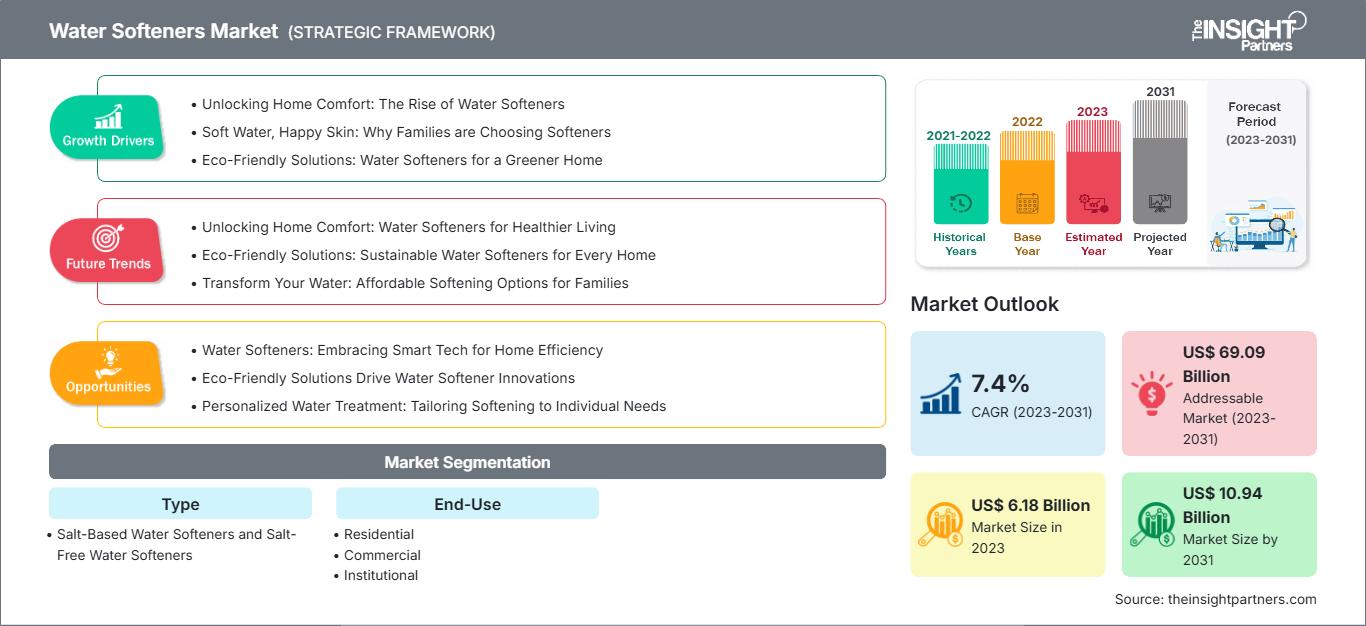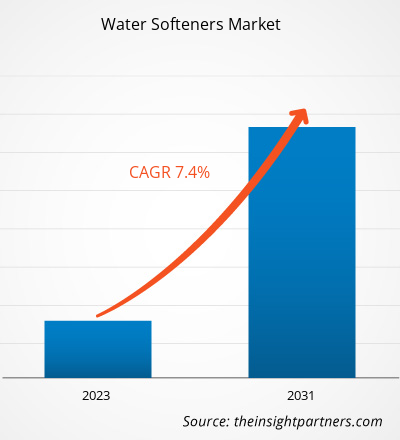Si prevede che il mercato degli addolcitori d'acqua raggiungerà i 10,94 miliardi di dollari entro il 2031, rispetto ai 6,18 miliardi di dollari del 2023. Si prevede che il mercato registrerà un CAGR del 7,4% tra il 2023 e il 2031. La crescente consapevolezza degli effetti nocivi dell'acqua dura rimarrà probabilmente una tendenza chiave del mercato degli addolcitori d'acqua.
Analisi del mercato degli addolcitori d'acqua
Il mercato degli addolcitori d'acqua ha registrato una crescita significativa negli ultimi anni, trainata dalla crescente consapevolezza degli effetti nocivi dell'acqua dura sugli impianti idraulici, sugli elettrodomestici e sulla qualità generale dell'acqua. L'acqua dura con alti livelli di calcio, magnesio e altri minerali pone sfide come l'accumulo di calcare e la formazione di residui di sapone, riducendo l'efficienza di scaldabagni e lavatrici. Di conseguenza, i consumatori residenziali, commerciali e istituzionali stanno adottando sempre più sistemi di addolcimento dell'acqua per superare questi problemi.
Panoramica del mercato degli addolcitori d'acqua
Gli addolcitori d'acqua stanno guadagnando una notevole popolarità grazie alla loro capacità di rimuovere minerali come calcio e magnesio dall'acqua, prevenendo la formazione di calcare e migliorando la qualità dell'acqua. L'urbanizzazione, l'industrializzazione, la necessità di acqua pulita, l'aumento del reddito disponibile e le mutevoli preferenze dei consumatori sono tra i principali fattori che contribuiscono alla crescita del mercato degli addolcitori d'acqua. Anche le normative governative che promuovono gli addolcitori d'acqua per ridurre gli sprechi contribuiscono all'espansione del mercato. Gli addolcitori d'acqua a base di sale sono la tipologia più utilizzata. Tra le principali regioni, il Nord America e l'Europa guidano il mercato a causa dell'elevata prevalenza di acqua dura.
Personalizza questo rapporto in base alle tue esigenze
Potrai personalizzare gratuitamente qualsiasi rapporto, comprese parti di questo rapporto, o analisi a livello di paese, pacchetto dati Excel, oltre a usufruire di grandi offerte e sconti per start-up e università
Mercato degli addolcitori d'acqua: Approfondimenti strategici

- Ottieni le principali tendenze chiave del mercato di questo rapporto.Questo campione GRATUITO includerà l'analisi dei dati, che vanno dalle tendenze di mercato alle stime e alle previsioni.
Potrai personalizzare gratuitamente qualsiasi rapporto, comprese parti di questo rapporto, o analisi a livello di paese, pacchetto dati Excel, oltre a usufruire di grandi offerte e sconti per start-up e università
Mercato degli addolcitori d'acqua: Approfondimenti strategici

- Ottieni le principali tendenze chiave del mercato di questo rapporto.Questo campione GRATUITO includerà l'analisi dei dati, che vanno dalle tendenze di mercato alle stime e alle previsioni.
Fattori trainanti e opportunità del mercato degli addolcitori d'acqua
La crescente consapevolezza degli effetti nocivi dell'acqua dura rafforza il mercato
L'acqua dura può portare all'accumulo di depositi di calcare negli impianti idraulici ed elettrodomestici, riducendone l'efficienza e la durata. Le soluzioni di addolcimento dell'acqua vengono adottate per proteggere varie apparecchiature, impianti idraulici e la salute umana dagli effetti dannosi dell'acqua dura. I sistemi di addolcimento dell'acqua consentono agli utenti residenziali di prolungare la longevità delle loro infrastrutture domestiche. L'acqua dura può lasciare la pelle secca e i capelli fragili a causa dei depositi minerali residui sulla superficie di pelle e capelli. Poiché le persone cercano di risolvere questi problemi di cura personale, la domanda di addolcitori d'acqua è aumentata negli ultimi anni. Inoltre, i potenziali benefici per la salute derivanti dalla riduzione del consumo di acqua dura, in particolare per quanto riguarda la salute cardiovascolare, sottolineano ulteriormente l'importanza dei sistemi di addolcimento dell'acqua nelle abitazioni.
La crescente adozione di addolcitori d'acqua nelle economie emergenti crea significative opportunità di crescita
L'urbanizzazione e l'industrializzazione sono tendenze di spicco in paesi come India e Cina. Con la crescita della popolazione urbana e l'espansione delle attività industriali, la domanda di addolcitori d'acqua è aumentata per affrontare le sfide poste dall'acqua dura in contesti residenziali e commerciali. Un'indagine condotta da KentRO a Bengaluru, in India, ha rilevato che il 24% delle aree della città riceve acqua dura, il che ha portato a un aumento dell'installazione di sistemi di addolcimento dell'acqua nelle abitazioni e nelle attività commerciali.
Analisi della segmentazione del rapporto di mercato degli addolcitori d'acqua
I segmenti chiave che hanno contribuito all'analisi del mercato degli addolcitori d'acqua sono la tipologia, l'utilizzo finale e il canale di distribuzione.
- In base alla tipologia, il mercato degli addolcitori d'acqua si divide in addolcitori d'acqua a base di sale e addolcitori d'acqua senza sale. Il segmento degli addolcitori d'acqua a base di sale ha detenuto una quota di mercato maggiore nel 2023.
- In base all'utilizzo finale, il mercato degli addolcitori d'acqua si divide in residenziale, commerciale (hotel e lodge, ristoranti, uffici, ospedali e altri) e istituzionale. Il segmento residenziale ha detenuto la quota di mercato maggiore nel 2023.
- In base al canale di distribuzione, il mercato degli addolcitori d'acqua si divide in diretto e indiretto. Il segmento diretto ha detenuto una quota di mercato maggiore nel 2023.
Analisi della quota di mercato degli addolcitori d'acqua per area geografica
L'ambito geografico del rapporto sul mercato degli addolcitori d'acqua è suddiviso principalmente in cinque regioni: Nord America, Asia-Pacifico, Europa, Medio Oriente e Africa e America meridionale e centrale.
L'Asia-Pacifico ha detenuto una quota significativa del mercato degli addolcitori d'acqua nel 2023. Con l'aumento della popolazione, il consumo di acqua è in rapido aumento in tutta la regione. Il carico sugli impianti di trattamento delle acque comunali in tutta la regione è aumentato significativamente a causa della necessità di soddisfare la crescente domanda di acqua potabile e servizi igienici. A causa delle limitazioni infrastrutturali, le aziende municipalizzate in paesi come Cina e India non sono in grado di gestire in modo efficiente l'acqua dura. Secondo la Banca Asiatica di Sviluppo, si stima che entro il 2050 circa 3.400 milioni di persone in Asia vivranno in aree a rischio idrico. Tali statistiche sottolineano la necessità di implementare approcci di riciclo e riutilizzo dell'acqua, che alimenteranno la domanda di addolcitori d'acqua nei prossimi anni.
Notizie e sviluppi recenti sul mercato degli addolcitori d'acqua
Il mercato degli addolcitori d'acqua viene valutato raccogliendo dati qualitativi e quantitativi a seguito di ricerche primarie e secondarie, che includono importanti pubblicazioni aziendali, dati di associazioni e database. Di seguito sono riportati alcuni degli sviluppi chiave nel mercato degli addolcitori d'acqua:
- Organica Water sta raccogliendo fondi istituzionali per espandere le proprie attività. (Fonte: Organica Water, News, 2023)
- SpringWell Water ha esteso le sue vendite in Canada per ampliare la portata della sua offerta di prodotti in nuove aree geografiche che presentano opportunità di crescita e rafforzare la sua missione: fornire a ogni famiglia acqua potabile pulita, rinfrescante e priva di contaminanti. (Fonte: SpringWell Water, News, 2021)
Addolcitori d'acquaApprofondimenti regionali sul mercato degli addolcitori d'acqua
Le tendenze regionali e i fattori che influenzano il mercato degli addolcitori d'acqua durante il periodo di previsione sono stati ampiamente spiegati dagli analisti di The Insight Partners. Questa sezione illustra anche i segmenti e la geografia del mercato degli addolcitori d'acqua in Nord America, Europa, Asia-Pacifico, Medio Oriente e Africa, America Meridionale e Centrale.
Ambito del rapporto di mercato sugli addolcitori d'acqua
| Attributo del rapporto | Dettagli |
|---|---|
| Dimensioni del mercato in 2023 | US$ 6.18 Billion |
| Dimensioni del mercato per 2031 | US$ 10.94 Billion |
| CAGR globale (2023 - 2031) | 7.4% |
| Dati storici | 2021-2022 |
| Periodo di previsione | 2023-2031 |
| Segmenti coperti |
By Tipo
|
| Regioni e paesi coperti | Nord America
|
| Leader di mercato e profili aziendali chiave |
|
Densità degli operatori del mercato degli addolcitori d'acqua: comprendere il suo impatto sulle dinamiche aziendali
Il mercato degli addolcitori d'acqua è in rapida crescita, trainato dalla crescente domanda degli utenti finali, dovuta a fattori quali l'evoluzione delle preferenze dei consumatori, i progressi tecnologici e una maggiore consapevolezza dei vantaggi del prodotto. Con l'aumento della domanda, le aziende stanno ampliando la propria offerta, innovando per soddisfare le esigenze dei consumatori e sfruttando le tendenze emergenti, alimentando ulteriormente la crescita del mercato.

- Ottieni il Mercato degli addolcitori d'acqua Panoramica dei principali attori chiave
Copertura e risultati del rapporto sul mercato degli addolcitori d'acqua
Il rapporto "Dimensioni e previsioni del mercato degli addolcitori d'acqua (2021-2031)" fornisce un'analisi dettagliata del mercato che copre le seguenti aree:
- Dimensioni e previsioni del mercato degli addolcitori d'acqua a livello globale, regionale e nazionale per tutti i segmenti di mercato chiave coperti dall'ambito
- Tendenze del mercato degli addolcitori d'acqua e dinamiche di mercato come fattori trainanti, vincoli e opportunità chiave
- Analisi dettagliata delle cinque forze PEST/Porter e SWOT
- Analisi del mercato degli addolcitori d'acqua che copre le principali tendenze del mercato, il quadro globale e regionale, i principali attori, le normative e i recenti sviluppi del mercato
- Analisi del panorama industriale e della concorrenza che copre la concentrazione del mercato, l'analisi della mappa termica, i principali attori e i recenti sviluppi per il mercato degli addolcitori d'acqua
- Profili aziendali dettagliati
- Analisi storica (2 anni), anno base, previsione (7 anni) con CAGR
- Analisi PEST e SWOT
- Valore/volume delle dimensioni del mercato - Globale, Regionale, Nazionale
- Industria e panorama competitivo
- Set di dati Excel
Report recenti
Rapporti correlati
Testimonianze
Motivo dell'acquisto
- Processo decisionale informato
- Comprensione delle dinamiche di mercato
- Analisi competitiva
- Analisi dei clienti
- Previsioni di mercato
- Mitigazione del rischio
- Pianificazione strategica
- Giustificazione degli investimenti
- Identificazione dei mercati emergenti
- Miglioramento delle strategie di marketing
- Aumento dell'efficienza operativa
- Allineamento alle tendenze normative




















 Ottieni un campione gratuito per - Mercato degli addolcitori d'acqua
Ottieni un campione gratuito per - Mercato degli addolcitori d'acqua